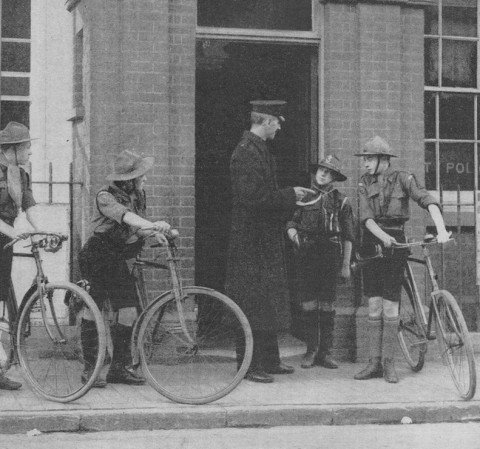In July, 1917, a new scheme for warning the people of London of impending air raids was adopted. When enemy aircraft were approaching, policemen with a notice warning passers-by to "take cover" went out on bicycles, blowing their whistles to attract attention. When all danger had passed, Boy Scouts went round blowing bugles.
Caption and image source: Hamilton Fyfe, 'Might and menace of raiding giants', in John Hammerton, ed., War in the Air: Aerial Wonders of our Time (London: Amalgamated Press, n.d. [1935?]), 344.
![]() This work is licensed under a Creative Commons Attribution-NonCommercial-NoDerivatives 4.0 International License.
Permissions beyond the scope of this license may be available at http://airminded.org/copyright/.
This work is licensed under a Creative Commons Attribution-NonCommercial-NoDerivatives 4.0 International License.
Permissions beyond the scope of this license may be available at http://airminded.org/copyright/.






Idle Historian
The man with the bicycle and warning placard is amazing. It's like something out of "Dad's Army"!
Brett Holman
Post authorIt seems hard to believe that anyone thought that was a good idea! But the previous one was even worse: maroons. Little rockets which explode in the air. Yes, the sounds of explosions are just the thing when you'd like people to take cover in an orderly fashion before an air raid...
Ian Evans
My mother (b. 1909) remembered the coppers on bicycles, so they made some impression. She said they used to ring hand bells too, though I'm not sure if that was "take cover" or "all clear"
Erik Lund
Obligatory.
Chris Williams
Though it's easy to be enormously condescending about the last link in the chain, the police on bikes were ultimately being told what to do by ADGB, Ashmore's control room, which was the first air defence system ever... So not all silly.
Ian Brown
If you think maroons were out of date in World War 11 I take it that you don't know they were still ready for use in the 1990s?
To raise the alarm of an air attack in the UK the government had a system of sirens operated by telephone from central warning points.
But in very rural areas police officers had maroons to fire.
There are several books about all this stuff and even training videos on the internet,one of them is called "RAISE THE ALARM".
Neil Datson
In the 1970s my father's telephone was fitted up with extra equipment so that he could be the village's air raid warden. Obviously, it was the threat of a nuclear attack from the Soviet Union that was being provided against. The system was tested every two or three years with the broadcast of a codeword. He was also given a hand-cranked siren, that must have made one heck of a din if worked vigourously enough; it was easy to get a good noise out of it by turning it fairly gently. We didn't dare turn it at full speed!
Goodness knows what was supposed to happen after that, as no provision had been made for shelters, but presumably they might have been built during a period of high tension.
At the time the whole palaver seemed little more than a family joke. Nobody believed that there would be any point in taking cover if the Soviets started throwing nuclear warheads around. As we're about half way between RAF Brize Norton and RAF Upper Heyford (where the US based F1-11s) we'd likely enough have one dropped in the immediate vicinity. I still have the siren in an outhouse, and it still works.
Brett Holman
Post authorChris:
That's a fair cop -- though I think it's a pretty sorry state of affairs if we aren't allowed laugh at police on bikes. More seriously, though, this was just before LADA and Ashmore came along (which was in early August). The raid warnings came about as a result of public pressure in June and July and were a separate thing, though I assume when LADA started it became responsible for warning the Home Office. But it's true that this was an evolving system, and we shouldn't project 1940 back to 1917. The police-on-bikes do in fact seem to have been reasonably effective, whereas experiments with sirens were deemed a failure.
Neil:
Yes, under Protect and Survive the public would have been told to make their own fallout shelters in periods of danger. But why wait -- start now! And keep that siren handy!
JDK
Ian, I think Brett's comment re- maroons was probably more about the oddity of using small explosions to warn of forthcoming larger ones!
FWIW, living in rural Victoria we need a similar warning system for bushfires. It's notable that in the 21st century, the local hamlet has a siren on the CFA fire station, that the Victorian Government haven't managed to make text messages an effective means of communication, and the 'best' warning we have is radio broadcasts (based on a robust network informing battery-powered radios as individual alerts). The list of technical failures (including alert systems) for the Black Saturday bushfires illustrate how difficult we find it to run an effective warning system even now.
Brett Holman
Post authorThat's another of my failed projects...links between British air raid precautions in the 1930s and the Blitz and the origins of Victoria's civil defence against both bushfires and air attack in 1939/1942, and the response to the 2009 bushfires. Even the names were recycled (Black Friday 1939, Black Saturday 1940 and 2009).